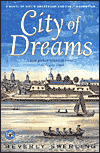
In 1661 a brother and sister stagger off a small wooden ship after eleven perilous weeks at see to seek a new life in the rough and rowdy Dutch settlement of Nieuw Amsterdam. Lucas Turner is a barber surgeon, Sally Turner an apothecary. Both gifted healers, they are bound to each other by blood and necessity. But as their new lives unfold, betrayal and murder will make them deadly enemies.
In their struggle to survive in the New World, both make choices that will burden their descendants - dedicated physicians and surgeons, pirates and whoremasters - with a legacy of secrets and retribution. The is heritage will set cousin against cousin, physician against surgeon, and ultimately, patriot against Tory.
In a city where black slaves are burned alive on Wall Street, where James Madison and Thomas Jefferson walk The Broad Way arguing America's destiny, and one of the greatest hospitals in the world is born in a former shipwright's workshops by the East River, the fortunes of the Turner and Devreys families are inextricably entwined.
Their pride and ambition, their loves and their hates and their determination to live by their own rules will shape the future of medicine - and the becoming of the dream that is New York.
I actually finished this book about a week ago, came and created this post, and then left it in draft until now, so if I am a little vague, that will be why!
Subtitled A Novel of Nieuw Amsterdam and Early Manhattan, this is mainly the story of Lucas and Sarah Turner and their descendants. When Lucas and Sarah make the trip to the New World, they are looking for a new start where they will be free to live as they want to. For Lucas that means for him to operate as a surgeon and to have the opportunity to be able to try out some of his medical theories and for Sarah, that she can become an apothecary. When Lucas falls in love with a married woman, there are unexpected consequences that begins to impact the future of his family.
When Lucas agrees that Sarah can marry Jacob de Vries she is mortified, and thus begins a feud that will not only last the lifetime of Sarah and Lucas, but then escalate throughout the generations of their family... although it does have to be said that the next generations are happy to start feuds on their own.
The most interesting of their descendants is probably Jennet, who starts life as a young girl with a talent with the knife (as in surgery). It is however unthinkable for a woman to be a doctor in those days and so she takes to secretly innoculating people against smallpox and attempting to provide medical aid to those that she can in secret.
When she marries, her husband asks her to give it up, and she does so. When her husband returns from a journey as a shadow of his former self, she is transformed from a loving wife to a hard nosed business woman whose interests include several brothels. As she raises her son, her wealth increases, but really her focus is on destroying one of her relatives because of the way he treated her when they were younger.
Swerling takes us on a journey through the descendant's lives, and those of some of their slaves, servants and friends, whilst at the same time giving us glimpses into the life and times of Nieuw Amsterdam, or New York as the city became known as later, touching important events in the city's history without overwhelming with historical information.
I had seen this book recommended quite a few times as a book that fans of Diana Gabaldon would really enjoy, and I can see how those comparisons can be made. The differences between the two authors:
Swerling covers quite a long period of time in one book. This book starts in 1661 and ends in 1798. Can you imagine how many books Gabaldon would take to cover that same timeframe?
Swerling covers seven generations of the two families, instead of focusing just on the one or two generations.
Swerling is jumps in time between various sections throughout the book, and from generation to generation. She gives a sufficient amount of detail in relation to the key events that in the lives of her characters as opposed to dwelling on everyday life.
The similarities:
In the Outlander series, Gabaldon is just building up to the American Revolution and has her characters interacting with some of the main historical figures. Swerling also brings us a section of the story from that time, and there is also some interaction with historical people, although it is only part of the stories.
Swerling also likes to give us details relating to medical procedures, cures and experiments of the time. The main difference is that her characters are doing trial and error experiments from scratch, whereas Claire at least knew where to start with her knowledge from the 20th century.
I really enjoyed watching New York grow throughout the series, from a town that stretched a mile from the port, to a town where there are elegant brick buildings, and quite a sizeable town over 100 years later.
There are significant enough differences that anyone who doesn't like Gabaldon's work may enjoy this, whilst fans of the Outlander series will also likely enjoy it as well!
The first 130 pages or so of this book were exceptional, and whilst the rest of the book was still enjoyable it didn't quite maintain that high standard all the way through. If there was anything that I wasn't sure of it was of the last few pages, but I believe that there is a sequel out soon so maybe that will clarify things for me a bit more.
I really, really enjoyed this book, and will definitely be reading more of her work.
Rating 4.5/5







I really want to read this book
ReplyDeleteI've looked at this book several times in the library and bookstore and thought it looked really good. Seeing NYC grow from its early days does sound interesting.
ReplyDelete